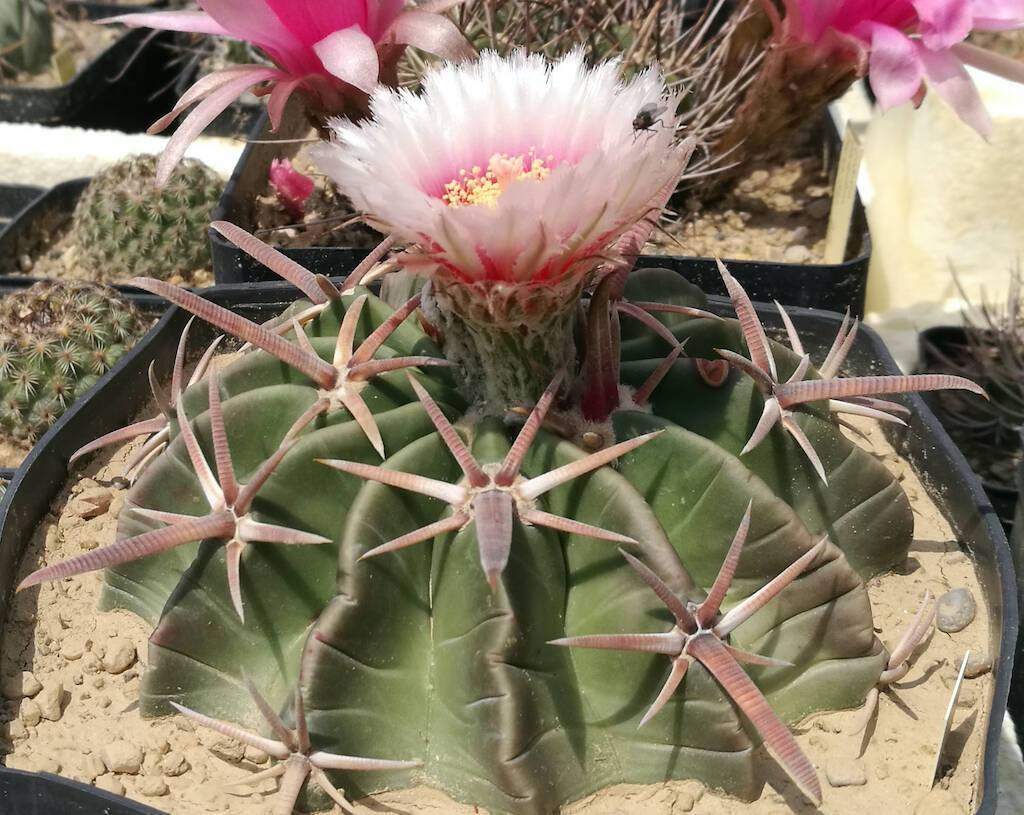The following is an in-depth article on the Echinocactus texensis species that I wrote some time ago and which, with my great pleasure, was published in the Cactus World magazine, published by the British Cactus & Succulents Society (BCSS). My thanks to editor Al Laius for the publication in the prestigious magazine. (…)
This peculiar cactus has a debatable scientific name and a slew of common ones. Echinocatus texensis is an extraordinary cactus, not very well known, and relatively uncommon in cultivation, yet it possesses all the characteristics that make a cactus well-worth growing. These include its compact and rounded appearance, robust and colourful spines, beautiful blooms, resistance to drought and high tolerance to direct sun as well as tolerating low winter temperatures. In addition, it has very decorative deep-red fruits (some of the most beautiful among cacti) and a relative simplicity of cultivation combined with a high predisposition for using the “wild” technique. This means reproducing, as much as possible, the conditions that cacti grow in their habitat, and paying attention to the substrate, direct exposure to the sun, very spartan cultivation, etc.
Origin and habitat
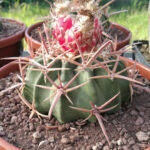
Echinocactus texensis (or Homalocephala texensis according to the original classification by Britton and Rose) is a cactus native to the south-eastern United States, particularly in New Mexico, southwestern Oklahoma and a good part of Texas (hence the name given to this species). It also grows in some Mexican regions, particularly in the north-eastern areas of the Sierra Madre, in Coahuila, Nuevo Léon, and Tamaulipas states. According to some sources, this species also grows in Chihuahua, Durango and Zacatecas. E. texensis grows from near sea-level up to 1,000m in very heterogeneous sub-desert areas: from xerophilous (arid) scrub to grasslands, broad clearings in forested areas, plains, valleys, and low hills. This indicates that the soils into where E. texensis sinks its roots can be highly variable, but are primarily calcareous and sandy. One thing is certain, and that is that this cactus almost always grows hidden among grasses or in areas where there is some vegetation consisting of bushes and small shrubs. The presence of shrubs and grasses indicate a substrate richer in organic matter than that in which some other cacti thrive (eg Ariocarpus and Pelecyphora). Dying and decomposing as an effect of short life cycles resulting from the aridity of these regions, the grasses enrich the organic component of the soil, and provide nutrients that would not otherwise occur. We therefore need to bear in mind then that in cultivating E. texensis we should think about using substrates that are not too poor in organic material, in particular with young specimens.
Classification and common names
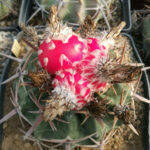
If the scientific name is debatable from the point of view of classification, namely Homalocephala texensis or Echinocactus texensis, then common names abound. In the US, where these plants grow, they are called Candy Cactus, Devil’s Head Cactus, Devil’s Pincushion, or Horse Crippler. In Mexico, E. texensis is also commonly called Mancacaballo, Monco Caballo or Viznaga (Anderson, 2001: 227–229). Regarding its scientific classification, for many years this plant has been included in the genus Homalocephala by Britton and Rose, where it contained just one species, H. texensis. Later on, several authors decided to eliminate the genus Homalocephala and move the species texensis into the genus Echinocactus, together with the species grusonii, platyacanthus (ingens), horizonthalonius, parryi and polycephalus. In recent years, reopening the debate, many researchers believe it is appropriate to restore the genus Homalocephala, including the species texensis, parryi and polycephalus. In support of this, a study by several authors (Vargas-Luna et al, 2018), address the issue from a genetic point of view. In the introduction, the authors argue, “…we propose to recognize a monophyletic Echinocactus and a monophyletic Homalocephala as two distinct genera with their molecular and morphological synapomorphies”. In summary, if we follow their work, the genus Echinocactus will contain only the species grusonii, platyacanthus and horizonthalonius, and the genus Homalocephala will include texensis, parryi and polycephalus.
To further complicate our lives, we find that in the original genus Echinocactus there were four taxa: E. polycephalus subsp. xeranthemoides, E. polycephalus subsp. polycephalus, E. horizonthalonius subsp. nicholii (L.D. Benson) and E. horizonthalonius subsp. horizonthalonius (Coulter, 1896, Benson, 1969). Strictly speaking, accepting the new distinction, the two E. polycephalus taxa would now be considered to belong to the genus Homalocephala.
Description
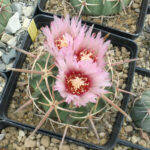
Echinocactus (or Homalocephala) texensis is a solitary plant that does not offset, even in old age (unless it has suffered damage to the growing point). The formative stem shape is globular, but with time it assumes a flattened shape, depressed at the apex. In nature, the body can be up to 20cm high, with a diameter of about 30cm. The stem is divided into very pronounced ribs with a thin, sharp edge; in adult specimens, the number of ribs varies from a dozen to 25, Anderson (2001) records 27, and Lodi (1997) 25. The body colour is light green or dark green (during the winter, it can redden, especially along the ribs) and the areoles, from which the spines appear, are quite widely spaced. In young specimens, the areoles are woolly, a detail that is common to all Echinocactus, at least in their development phase.
The spines, initially thin and weak, become wide, thick and very strong. In adult specimens, there are six radial spines (Lodi notes 6 or 7 of them) up to 4 or 5cm in length, and a central spine up to 7cm long (exceptionally even more), thick and broad, flattened, sharp and slightly curved downward at the end. Some may have a short, thick central spine. I think this variability may be determined by a genetic response to local conditions. New spines are red, but they tend to fade to pink, greyish and almost white lower down. The spine surface shows transverse ridges that testify to the age of the plant. They are velvety to the touch, and when wet, the spines of E. texensis take on a brilliant, showy, bright-red colour. The phenomena of longitudinal ‘splitting’ of the central spine is sometimes observed in E. texensis, in effect producing a forked central spine. I have observed this in photos, but it has never happened in my collection.
Flowers, fruits and seeds
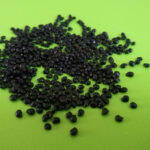
The flowers of E. texensis are pale pink to white, with a red or orange throat, and emerge at the apex in spring, usually around April. The corollas can reach a diameter of 5–6cm, and the tepals have the peculiarity of terminal fringing. The yellow stigma lobes provide a handsome contrast. The aspect and consistency of the flowers are reminiscent of silk. I am not aware that the flowers are self-fertile (ie able to pollinate themselves). Nevertheless, I have noticed that both pollination and the consequent formation of the fruit are very easy. The fruits, which form from the end of May, are very large and showy (up to 3–4cm in diameter and 4–5cm long), fleshy, and at the same time extremely firm in texture. They are bright red and have smooth skin interspersed with small scales. According to some authors, the fruits are edible, and because they are (or were) utilised for producing candies, these plants are also called Candy Cactus. However, I do not have any direct evidence of this, and the definition of Candy Cactus could be simply due to the appearance of plants with ripe fruits, which can resemble small sweets. The seeds are medium-sized, not as large as those of Opuntia, for example, but easily handled, oblong and black in colour with a shiny cuticle.
Cultivation
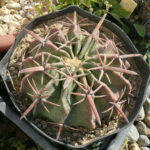
The cultivation of E. texensis is easy enough, much like all species in the genus Echinocactus, with the exception of E. polycephalus, which is regarded as difficult and not recommended for the less experienced. In over twenty years of growing E. texensis I have noticed only one problem, which is that this plant seems to be inclined to lose its roots much more easily than other cacti. In my opinion, it may be due to environmental stress or using the wrong potting soil. Over the years, I have experimented with different soils for E. texensis, from purely mineral substrates to mixtures richer in organic matter (peat or earthworm humus). The results indicate that these plants need a fair amount of organic matter in the substrate, not only when they are still seedlings but also as adults. It is no coincidence that the best results have been obtained by growing E. texensis in a mix of equal parts of pumice, grit and peat. I had mediocre results with potting soils made of field soil (loam), aggregates such as pumice, and a small part of peat or humus (maximum 10%). I have never experimented with marl (a type of fine clay) with these plants, but I do not rule out trying it as soon as possible in percentages not exceeding 50% and with the addition of at least 30% organic material. E. texensis, like all Echinocactus, need lots of light. As the plants reach at least three or four years old, from the end of March, they will benefit from being gradually introduced to full sunlight. Proper exposure will go a long way toward forming strong spines and keeping the body low and compact.
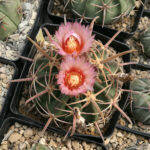
As far as temperatures are concerned, these cacti are very tolerant and resistant. They can easily stand the blazing sun with more than 40°C, provided they are kept outdoors and have plenty of air movement. During the European winter, if kept completely dry from late September, they can go well below freezing without damage. I had specimens that have spent a few nights at -10°C and, except for a slight reddening of the epidermis, which disappeared with the arrival of spring, they did not suffer any damage. According to some sources, E. texensis can withstand temperatures as low as -18°C, but I have no direct experience of this. The watering and fertilising regime does not differ from that of most cacti. I give plenty of water in the growing season, from April to September, as long as the soil has time to dry between watering, and no water at all from the end of September to the end of March. Some recommend watering E. texensis lightly, but even using potting soils with 30% organic content, I have never experienced rot, even with heavy watering. I keep several specimens outside the greenhouse, which have experienced a week’s worth of rain on several occasions with no loss of life or damage.
All my plants, including E. texensis, receive a low-nitrogen cactus fertiliser a couple of times a year during the growing season as the slightly more organic substrate which I use already helps provide some nutrients. I have noticed that E. texensis comes into growth quite early, at least here in Northern Italy, starting from the end of February, when they begin to produce new spines.
Propagation
The only way to reproduce this species is by sowing seed, since they do not produce offsets. The procedure is probably easier when compared to the sowing of some other cacti by the fact that the seeds of E. texensis are easy to handle because of their larger size.
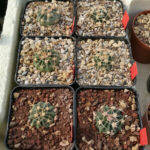
According to most growers, E. texensis seeds do not need any special treatment, such as scarification, which is necessary or strongly recommended to germinate Echinocactus horizonthalonius, E. parryi and E. polycephalus. From my experience, E. texensis seeds germinate well without any treatment. However, some growers suggest that scarification could further increase germination if done correctly. I have always sowed E. texensis in natural light and heat, in April, without any particular procedure, except to soak the seeds for 24 hours with the sole purpose of hydrating them and softening the cuticle, which seems to me to be quite leathery. I am planning some experiments with both scarified and non-scarified seeds, having many at my disposal originating from plants grown under the same conditions.
How to sow cacti and succulent plants.
Literature
- Anderson, E. F. (2001) The Cactus Family. Timber Press.
- Lodi, G. (1997) Le mie piante grasse. Edagricole. pp 75–76.
- Vargas-Luna, M D et al (2018) Splitting Echinocactus: morphological and molecular evidence support the recognition of Homalocephala as a distinct genus in the Cacteae. PhytoKeys 111: 31–59.
- Vermeulen, N. (1999) Cactus. Idea Libri Srl. pp 56.
Correlated links
Cultivation cards in pdf
Knowledge and curiosity
Echinocactus grusonii: a little history
Wild cultivation
SUBSCRIBE TO THE SITE – If you liked this article, subscribe to the site to have unlimited access to all the contents for one year or three months depending on the formula you choose. Here you will find terms and conditions.
SUBSCRIBE TO THE NEWSLETTER – If you want to receive the free newsletter every time new content is published, fill in the fields at this link!
© The texts, videos, photos and graphic elaborations of the site “Il fiore tra le spine” are original material and are covered by copyright. It’s forbidden to reproduce them in any way.


